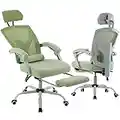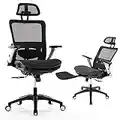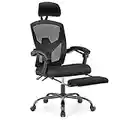In today's work culture, many of us spend the majority of our days sitting at a desk, engrossed in our work. In this environment, one piece of furniture that holds significant importance is the humble office chair. An uncomfortable chair can lead to a myriad of health issues, including back pain, neck tension, and other musculoskeletal problems. Not to mention, it can severely hinder your productivity. Conversely, the right office chair can transform your work experience, promoting comfort, wellness, and efficiency. In this comprehensive guide, we'll explore how to choose an ideal office chair, delve into the benefits of ergonomic design, offer tips on testing chairs for comfort, guide you on adjusting your chair for optimal support, and finally, discuss the types of materials used in chair construction.
Five Important Factors to Consider When Choosing an Office Chair
When it comes to boosting productivity and improving health at work, the importance of choosing the right office chair cannot be overstated. But what exactly should you look for in an office chair? Here are five critical factors:
1. Ergonomic Design: Ergonomics refers to the design of products and environments for human use. An ergonomic office chair should conform to your body's shape, promoting good posture and alleviating strain on your back.
2. Adjustability: The more options for adjustment an office chair has, the better. Look for chairs with adjustable seat height, armrests, backrests, and lumbar support.
3. Material and Padding: Comfort and durability are greatly influenced by the chair's material and padding. A good chair should have enough padding to be comfortable but not so much that it loses its shape over time.
4. Wheelbase and Swivel: A chair with a wheelbase and swivel capability can prevent strain from reaching across a desk. It allows for easy mobility without needing to stand up constantly.
5. Price: While it's tempting to go for the cheapest option, remember that you're investing in your comfort and health. High-quality chairs may have a higher upfront cost but offer better long-term value.
The Benefits of Ergonomic Office Chairs
Ergonomic office chairs come with a host of benefits. They're designed to support your body, especially your spine, to prevent the development of musculoskeletal disorders caused by poor posture. Here are some noteworthy benefits:
Reduced Back Pain: Ergonomic chairs are designed with lumbar support, reducing strain on the lower back, preventing long-term damage, and mitigating existing back pain.
Improved Posture: Features like adjustable seat height and backrest can help promote a neutral posture, reducing the risk of neck and shoulder strain.
Enhanced Productivity: When you're comfortable, you can focus better and work more efficiently. Ergonomic chairs can contribute to increased productivity.
Reduced Risk of Work-related Injuries: By promoting correct posture and providing necessary support, ergonomic chairs can significantly decrease the risk of work-related musculoskeletal disorders.
How to Test Different Types of Office Chairs for Comfort
While reviews and specifications can guide you, the true test of an office chair is how it feels. Here's how you can assess different types of office chairs for comfort:
1. Sit Down: The seat should be wide and deep enough for you to sit comfortably. You should be able to sit with your back against the backrest and have 2-4 inches between the back of your knees and the seat of the chair.
2. Check the Backrest: A good backrest should follow the natural curve of your spine. It should support the lower back and be adjustable in both angle and height.
3. Test the Armrests: When your arms are on the armrests, they should form a 90-degree angle, and your shoulders should feel relaxed.
4. Adjust the Height: Your feet should rest flat on the floor, and your thighs should be parallel to the floor. If not, adjust the chair's height.
5. Roll and Swivel: The chair should move smoothly, and you should be able to reach different areas of your desk without straining.
Tips for Adjusting Your Office Chair for Optimal Support
Now that you've selected your office chair, it's crucial to adjust it to fit your body perfectly. Here are some tips:
1. Adjust the Seat Height: Your feet should be flat on the floor, with your knees at a 90-degree angle. This helps to ensure proper circulation.
2. Fine-tune the Backrest: The backrest should follow the natural curvature of your spine. The lumbar support should fit snugly against your lower back.
3. Set the Armrests: When your shoulders are relaxed, your elbows should rest lightly on the armrests, forming a 90-degree angle.
4. Adjust the Seat Depth: There should be about a 2-4 inch gap between the back of your knees and the chair. If your chair has a seat slide mechanism, make use of it.
5. Tilt Tension Adjustment: If your chair has a recline function, adjust the tilt tension to match your body weight. This allows the chair to recline smoothly while providing adequate support.
Types of Materials Used in the Construction of Comfortable Office Chairs
The material of your office chair not only impacts its look and durability but also affects its comfort. Here are a few common materials:
Mesh: Mesh chairs are breathable, keeping you cool throughout the day. They're resilient and form a supportive cradle for your back, making them an excellent choice for prolonged use.
Leather: Leather chairs offer a luxurious look and feel. They're durable and comfortable, but they can get warm and might require more maintenance.
Fabric: Fabric chairs are comfortable and available in a wide range of colors and patterns. However, they can stain easily and may require regular cleaning.
Vinyl: Vinyl chairs are easy to clean and can mimic the look of leather. However, they can become uncomfortable in warmer environments due to their lack of breathability.
In conclusion, choosing the right office chair is a crucial investment in your work life. By considering the chair's ergonomics, adjustability, material, and other features, you can significantly improve your comfort, productivity, and overall well-being at work.



